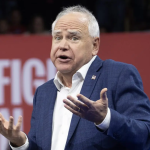The imaginary recession of 2019 is over.
The U.S. economy added 266,000 jobs for the month and the unemployment rate fell to 3.5 percent, matching the lowest level in 50 years.
Economists had expected the economy to add 187,000 jobs and for unemployment to remain unchanged at 3.6 percent, according to Econoday.
Adding to the picture of strength for the labor market, previous jobs numbers were revised up. September’s figure was revised up by 13,000 to 193,000. October was revised up by 28,000 to 156,000. Together, that adds 41,000 more jobs than previously reported.
The Friday report on nonfarm payrolls makes it clear that the economy is much stronger than thought by those who were predicting U.S. growth would slow dramatically or contract near year end.
Oops: Democrat Brags About Jasmine Crockett Endorsement with a Photograph of a Completely Different Black Woman
Democrats reveal whether Walz should testify and be held accountable for massive fraud under his watch
Trump’s Venezuela oil blockade puts Chevron in the middle of a high-stakes sanctions crackdown
2026 elections to keep an eye on
Bannon calls Ben Shapiro a ‘cancer’ in Turning Point conference speech
Trump administration touts ‘most secure border in history’ as 2.5 million migrants exit US
DOJ’s Epstein disclosure draws fire for website glitches, missing documents, redactions
Here is what‘s in the Department of Justice’s latest Epstein files drop
Bill Gates Pictured with Females in New Epstein Files Photo Release
New Epstein files reveal photos of Bill Clinton posing with unidentified women
Just In: Epstein File Dump Features Bill Clinton Next to Redacted ‘Victims and/or Minors’ in Multiple Pics
White House pressures Smithsonian for internal records, warns funding could be withheld: report
Brown University, MIT shooting suspect likely died days before body found: autopsy
New Epstein documents include photos of Bill Clinton shirtless in hot tub, socializing with Michael Jackson
BREAKING: US Launches Strikes on Syria in Response to Killing of 2 American Soldiers
Hiring in November was strong across the board. Manufacturing, which had been a source of weakness in earlier reports, added 54,000 jobs. This was boosted by the end of the strike at General Motors, with autos adding 41,000. But economists, whose estimates were meant to reflect the end of the strike, had predicted just 15,000 extra jobs.
Healthcare added 45,000 jobs, as did leisure and hospitality. Employment in professional and technical services grew by 31,000.
Average hourly wages are up 3.14 percent compared with last year, above economist expectations. In manufacturing, the average workweek increased by 0.1 hour to 40.5 hours. Average hourly ages of private-sector production and nonsupervisory employees rose by 7 cents in the month to $23.83, a 0.22 percent gain.
The labor force participation rate was little changed at 63.2 percent in November. The employment-population ratio was 61.0 percent for the third consecutive month. Both numbers would ordinarily be declining to do the expected retirement of baby-boomers. Holding steady indicates that the strong labor market is enticing workers to stay on the job.
Story cited here.
























